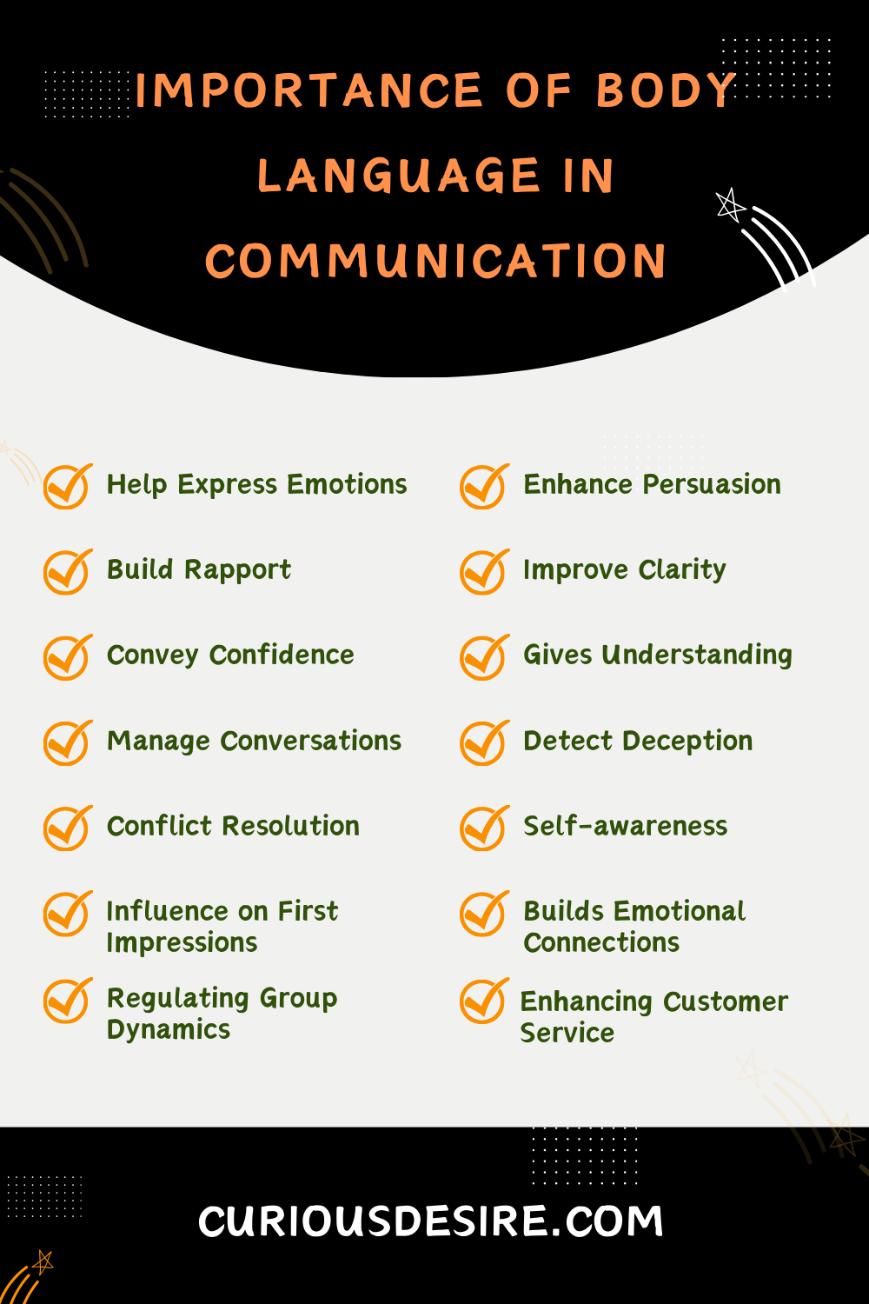Body language is really important when we communicate with others. It’s like a secret language our bodies use to express how we feel, even when we’re not talking.
It serves as a subtle yet potent communicator of our underlying emotions, attitudes, and intentions. It’s like adding extra meaning to our words without even saying anything.
In this article, we will see why body language matters so much in communication. We’ll learn how it helps us connect with others, build trust, and show people who we really are.
Let’s get into it!
[toc]

1. Help Express Emotions
Body language is a powerful tool for expressing emotions without using words. It’s like your body’s way of talking to others.
When you’re happy, your body might naturally show it by smiling, laughing, or bouncing around with energy.
Similarly, when you’re feeling sad, your body might reflect this by slumping your shoulders, avoiding eye contact, and maybe even shedding a tear.
These nonverbal cues help others understand your emotions without you having to say a word, making communication richer and more authentic.
2. Enhance Persuasion
When you’re trying to persuade someone, your body language can make a big difference in how convincing you are.
For instance, imagine you’re giving a presentation at work.
Standing up straight, making eye contact with your audience, and using confident hand gestures to emphasize your key points can make you seem more confident and trustworthy.
This confident body language can help make your arguments more persuasive because it shows you believe in what you’re saying.
3. Build Rapport
Building rapport is like making friends with someone. It’s about connecting with others in a friendly and genuine way.
You can do this by using positive body language like smiling, nodding, and leaning slightly toward the person you’re talking to.
When you use friendly body language, it makes people feel like you’re interested in what they have to say and that you’re friendly and approachable.
This helps create a positive connection and makes communication more enjoyable for everyone involved.
4. Improve Clarity
Sometimes, words alone might not fully explain what you mean. That’s where body language comes in.
By using gestures or facial expressions, you can add extra meaning to your words, making your message clearer and easier to understand for others.
For example, if you’re giving directions to someone and you use hand gestures to illustrate the route, it can help them visualize the directions more clearly.
Similarly, when you’re apologizing for a mistake, making direct eye contact and offering a sincere expression can reinforce the sincerity of your apology.
5. Convey Confidence
Confident body language makes you look and feel more self-assured.
Standing up straight with your shoulders back and making eye contact with others shows that you’re confident in yourself and what you’re saying.
This can make people listen to you more attentively and take you seriously.
For instance, imagine you’re in a job interview. If you sit up straight, maintain steady eye contact, and speak with a clear, assertive tone, you’ll exude confidence and competence.
This can leave a positive impression on the interviewer and increase your chances of success.
6. Facilitate Understanding
Body language adds depth to your communication by showing others how you feel or what you mean beyond just words.
If you’re excited about something, your body language might be energetic, with lots of gestures and a big smile.
This helps others understand your excitement even more than if you just said you were excited.
Similarly, when you’re expressing empathy or concern for someone, a comforting touch can convey your support more profoundly than words alone.
7. Manage Conversations
Body language helps regulate conversations by signaling when it’s your turn to speak or when you’re listening.
Leaning forward or nodding can show that you’re interested and engaged in the conversation while leaning back might indicate that you’re listening and thinking about what’s being said.
By using appropriate body language cues, you can ensure that conversations flow smoothly and everyone feels heard.
8. Detect Deception
Sometimes people might not be entirely honest with their words, but their body language can give them away.
Signs like avoiding eye contact, fidgeting, or crossing arms might indicate that someone isn’t being honest.
By paying attention to these cues, you can get a better sense of what someone is really thinking or feeling.
For instance, if someone says they’re fine but they’re avoiding eye contact and fidgeting, they might actually be upset or hiding something.
9. Negotiation and Conflict Resolution
In negotiation and conflict resolution, body language can help establish trust and promote cooperation.
For example, during a tense negotiation, maintaining an open, relaxed posture and using active listening cues like nodding and maintaining eye contact can signal your willingness to find a mutually beneficial solution.
Similarly, when resolving a conflict, displaying empathy through nonverbal cues like a reassuring touch or a sympathetic expression can help defuse tension and build rapport with the other party.
10. Self-awareness and Adaptability
Understanding your own body language allows you to adjust and adapt your communication style to different situations and audiences.
If you notice that your habit of crossing your arms makes you appear closed-off or defensive during meetings, you can consciously work on keeping them open and relaxed to appear more approachable.
By being aware of these cues and actively modifying your behavior, you can communicate more effectively and build stronger relationships with others.
11. Influence on First Impressions
When you meet someone for the first time, your body language speaks volumes before you even say a word.
Things like how firm your handshake is, how you stand, and the expression on your face can make a big impact.
If you greet someone with a warm smile, good posture, and a confident handshake, they’re more likely to see you in a positive light from the start.
This sets a good foundation for any future interactions and can lead to successful relationships.
12. Strengthening Emotional Connections
Body language is a powerful tool for building emotional connections and empathy with others.
Sometimes, a simple gesture like a pat on the back or a sympathetic nod can convey understanding and support more effectively than words alone.
These nonverbal cues help strengthen relationships and create a sense of closeness between people.
13. Regulating Group Dynamics
In group settings, body language can influence how well the group works together and collaborates.
Leaders who display inclusive body language, such as open gestures and attentive listening, make everyone feel welcome and valued.
This encourages participation and fosters a sense of belonging among group members, leading to more productive and harmonious group dynamics.
14. Enhancing Customer Service Interactions
In customer service roles, attentive body language is essential for making customers feel valued and supported.
When employees use positive nonverbal cues like smiling, making eye contact, and actively listening, it shows that they care about the customer’s needs and are willing to help.
This can lead to higher levels of customer satisfaction and loyalty, as customers feel more appreciated and understood.
Tips to Improve Body Language In Communication
Below are valuable tips to enhance your body language and transform into the communicator you aspire to be!
1. Practice Self-awareness
Start by paying attention to your own body language in different situations.
Notice how you stand, sit, gesture, and make facial expressions.
Reflect on how your body language might be perceived by others and how it aligns with your intended message.
2. Observe Others
Pay attention to the body language of people around you, both in real-life interactions and in media such as movies or TV shows.
Notice how different gestures, postures, and expressions convey emotions, attitudes, and intentions.
3. Maintain Good Posture
Stand and sit up straight with your shoulders back and your head held high.
Good posture conveys confidence, openness, and attentiveness.
Avoid slouching, crossing your arms, or fidgeting, as these can project discomfort or defensiveness.
4. Make Eye Contact
Establish and maintain appropriate eye contact during conversations.
This shows that you’re engaged and attentive.
However, be mindful not to stare excessively, as this can be perceived as intimidating or aggressive.
5. Use Gestures Purposefully
Incorporate gestures to emphasize key points or convey emotions.
Use natural, expressive hand movements that complement your speech.
However, avoid overly dramatic or distracting gestures that detract from your message.
6. Smile and Nod
Smiling and nodding are simple yet powerful gestures that convey warmth, friendliness, and agreement.
When appropriate, smile genuinely and nod affirmatively to show that you’re attentive and receptive.
7. Mind Your Space
Be mindful of personal space boundaries and respect the comfort zones of others.
Avoid invading someone’s personal space unless invited, and adjust your proximity accordingly based on cultural norms and social context.
8. Practice Active Listening
Demonstrate active listening through your body language by facing the speaker, making eye contact, nodding, and using encouraging gestures like leaning forward slightly.
This shows that you’re fully engaged and interested in what they’re saying.
9. Manage Stress and Anxiety
Work on managing stress and anxiety, as these can manifest in nervous body language such as fidgeting, avoiding eye contact, or speaking too softly.
Practice relaxation techniques, such as deep breathing or visualization, to help calm your nerves and project more confident body language.
10. Seek Feedback and Practice
Ask for feedback from trusted friends, colleagues, or mentors on your body language.
Practice using positive body language in different situations, such as during presentations, meetings, or social interactions, and gradually refine your nonverbal communication skills over time.
Importance Of Body Language In Communication FAQs
1. How can you show empathy through nonverbal communication?
Showing empathy through nonverbal communication involves conveying understanding, compassion, and support without using words.
Nonverbal cues such as facial expressions, tone of voice, and gestures play a crucial role in expressing empathy.
For example, maintaining eye contact, nodding in agreement, and offering a gentle touch or comforting pat on the back can convey empathy and solidarity with someone experiencing difficulty or distress.
Additionally, mirroring the emotions of others through subtle facial expressions and body language signals that you understand and share their feelings, further strengthening the connection and fostering a sense of emotional support.
2. How do you show empathy in conflict resolution?
In conflict resolution, demonstrating empathy is essential for fostering understanding, de-escalating tensions, and finding mutually acceptable solutions.
Nonverbal cues such as active listening, maintaining open body posture, and providing comforting gestures can convey empathy effectively.
By listening attentively, making eye contact, and nodding in acknowledgment, you signal that you understand and respect the perspectives and feelings of others involved in the conflict.
Additionally, offering genuine expressions of concern, such as a sympathetic smile or a reassuring touch, can help reassure individuals and create a conducive environment for productive dialogue and resolution.
3. What are the nonverbal cues of conflict?
Nonverbal cues of conflict can include tense body posture, facial expressions of frustration or anger, defensive gestures such as crossing arms or avoiding eye contact, and aggressive vocal tone or volume.
These cues may indicate discomfort, disagreement, or hostility in interpersonal interactions.
Additionally, fidgeting, rapid breathing, or flushing of the face can signal heightened emotional arousal or stress during conflict situations.
Awareness of these nonverbal cues is crucial for identifying and addressing underlying tensions or issues contributing to the conflict.
4. Why is nonverbal communication important in conflict resolution?
Nonverbal communication is vital in conflict resolution because it provides valuable insight into the emotions, attitudes, and intentions of individuals involved in the conflict.
While verbal communication conveys the explicit content of messages, nonverbal cues often reveal underlying emotions, unspoken concerns, and relational dynamics.
By paying attention to nonverbal signals such as body language, facial expressions, posture, and eye contact, mediators and participants can better understand the root causes of conflict, build rapport, and facilitate effective communication and resolution strategies.
5. How is body language important in communication?
Body language is essential in communication because it serves as a powerful means of conveying emotions, intentions, and attitudes nonverbally.
While words convey the explicit content of a message, body language adds depth, context, and nuance to communication, enriching the exchange of information and facilitating understanding between individuals.
By observing body language cues such as gestures, facial expressions, posture, and eye contact, communicators can glean valuable insights into the thoughts, feelings, and relational dynamics underlying verbal interactions.
6. What are the benefits of using body language?
The benefits of using body language in communication include enhancing clarity and understanding, fostering emotional connection and rapport, conveying authenticity and sincerity, and facilitating effective interpersonal interactions.
Body language adds richness and depth to communication, enabling individuals to express emotions, convey empathy, and build trust more effectively than words alone.
Additionally, mastering body language skills can improve one’s ability to interpret and respond to nonverbal cues from others, enhancing communication proficiency and interpersonal effectiveness.
7. What are the main components of body language?
The main components of body language include facial expressions, gestures, posture, eye contact, and tone of voice.
Facial expressions convey a wide range of emotions, from happiness and sadness to anger and surprise. Gestures, such as hand movements and nods, emphasize or complement verbal communication and convey additional meaning.
Posture reflects confidence, openness, or defensiveness, while eye contact signals attentiveness, sincerity, and connection.
The tone of voice adds emotional nuance and emphasis to spoken words, influencing the interpretation and impact of communication.
8. What are the benefits of using body language as a teacher?
Using body language as a teacher can enhance engagement, comprehension, and classroom management.
Nonverbal cues such as facial expressions, gestures, and body posture help convey enthusiasm, clarity, and authority, capturing students’ attention and maintaining their interest in the lesson.
Additionally, effective use of body language fosters rapport and connection with students, creating a positive and supportive learning environment.
Moreover, nonverbal cues can aid in classroom management by signaling expectations, reinforcing positive behavior, and addressing disruptions proactively.
9. What are the benefits of body language in the classroom?
In the classroom, body language serves several benefits, including facilitating communication, enhancing student engagement, and promoting positive teacher-student relationships.
Teachers’ use of nonverbal cues such as gestures, facial expressions, and body posture helps convey information, clarify concepts, and maintain students’ attention during lessons.
Additionally, positive body language creates a welcoming and inclusive learning environment, fostering a sense of trust, respect, and connection between teachers and students.
Moreover, effective use of body language can improve classroom dynamics, promote active participation, and support student learning and development.
10. What are the advantages and disadvantages of body language?
Advantages of body language include its ability to enhance communication, convey emotions, build rapport, and facilitate understanding in interpersonal interactions.
Body language adds richness and depth to communication, enabling individuals to express themselves more effectively and connect with others on a deeper level.
However, disadvantages of body language may arise when nonverbal cues are misinterpreted or misunderstood, leading to confusion, conflict, or miscommunication.
Additionally, cultural differences in body language norms and individual variations in interpreting nonverbal cues may pose challenges in cross-cultural communication contexts.
Overall, while body language offers numerous benefits, it is essential to be mindful of its limitations and potential for misinterpretation in communication.


